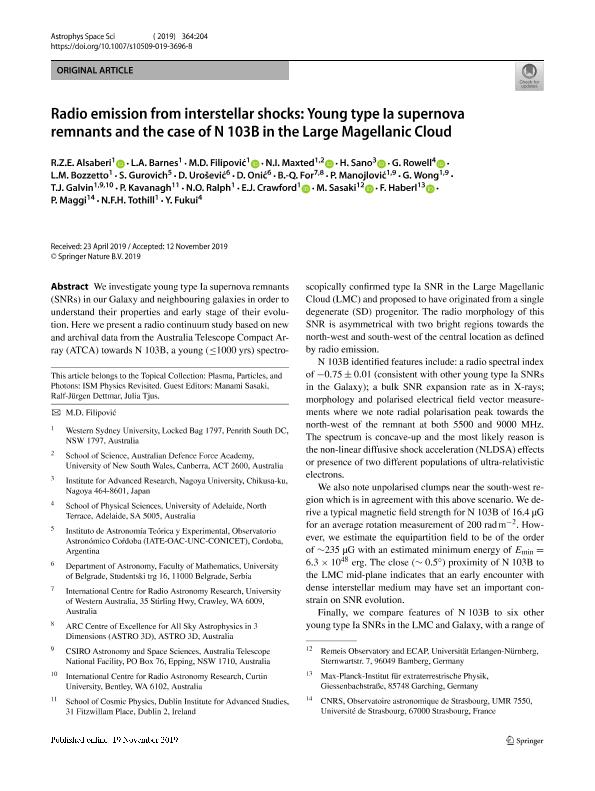Artículo
Radio emission from interstellar shocks: Young type Ia supernova remnants and the case of N 103B in the Large Magellanic Cloud
Alsaberi, Rami Z. E.; Barnes, L. A.; Filipovic, Miroslav; Maxted, Nigel; Sano, H.; Rowell, Gavin; Bozzetto, L. M.; Gurovich, Sebastian ; Urošević, D.; Onić, D.; For, B. Q.; Manojlović, P.; Wong, G.; Galvin, T. J.; Kavanagh, P.; Ralph, N. O.; Crawford, Evan; Sasaki, Manami; Haberl, Frank; Maggi, P.; Tothill, N. F. H.; Fukui, Y.
; Urošević, D.; Onić, D.; For, B. Q.; Manojlović, P.; Wong, G.; Galvin, T. J.; Kavanagh, P.; Ralph, N. O.; Crawford, Evan; Sasaki, Manami; Haberl, Frank; Maggi, P.; Tothill, N. F. H.; Fukui, Y.
 ; Urošević, D.; Onić, D.; For, B. Q.; Manojlović, P.; Wong, G.; Galvin, T. J.; Kavanagh, P.; Ralph, N. O.; Crawford, Evan; Sasaki, Manami; Haberl, Frank; Maggi, P.; Tothill, N. F. H.; Fukui, Y.
; Urošević, D.; Onić, D.; For, B. Q.; Manojlović, P.; Wong, G.; Galvin, T. J.; Kavanagh, P.; Ralph, N. O.; Crawford, Evan; Sasaki, Manami; Haberl, Frank; Maggi, P.; Tothill, N. F. H.; Fukui, Y.
Fecha de publicación:
11/2019
Editorial:
Springer
Revista:
Astrophysics And Space Science
ISSN:
0004-640X
Idioma:
Inglés
Tipo de recurso:
Artículo publicado
Clasificación temática:
Resumen
We investigate young type Ia supernova remnants (SNRs) in our Galaxy and neighbouring galaxies in order to understand their properties and early stage of their evolution. Here we present a radio continuum study based on new and archival data from the Australia Telescope Compact Array (ATCA) towards N 103B, a young (≤1000 yrs) spectroscopically confirmed type Ia SNR in the Large Magellanic Cloud (LMC) and proposed to have originated from a single degenerate (SD) progenitor. The radio morphology of this SNR is asymmetrical with two bright regions towards the north-west and south-west of the central location as defined by radio emission. N 103B identified features include: a radio spectral index of − 0.75 ± 0.01 (consistent with other young type Ia SNRs in the Galaxy); a bulk SNR expansion rate as in X-rays; morphology and polarised electrical field vector measurements where we note radial polarisation peak towards the north-west of the remnant at both 5500 and 9000 MHz. The spectrum is concave-up and the most likely reason is the non-linear diffusive shock acceleration (NLDSA) effects or presence of two different populations of ultra-relativistic electrons. We also note unpolarised clumps near the south-west region which is in agreement with this above scenario. We derive a typical magnetic field strength for N 103B of 16.4 μG for an average rotation measurement of 200radm−2. However, we estimate the equipartition field to be of the order of ∼235 μG with an estimated minimum energy of Emin=6.3×1048erg. The close (∼ 0.5 ∘) proximity of N 103B to the LMC mid-plane indicates that an early encounter with dense interstellar medium may have set an important constrain on SNR evolution. Finally, we compare features of N 103B to six other young type Ia SNRs in the LMC and Galaxy, with a range of proposed degeneracy scenarios to highlight potential differences due to a different models. We suggest that the single degenerate scenario might point to morphologically asymmetric type Ia supernova explosions.
Archivos asociados
Licencia
Identificadores
Colecciones
Articulos(IATE)
Articulos de INST.DE ASTRONOMIA TEORICA Y EXPERIMENTAL
Articulos de INST.DE ASTRONOMIA TEORICA Y EXPERIMENTAL
Citación
Alsaberi, Rami Z. E.; Barnes, L. A.; Filipovic, Miroslav; Maxted, Nigel; Sano, H.; et al.; Radio emission from interstellar shocks: Young type Ia supernova remnants and the case of N 103B in the Large Magellanic Cloud; Springer; Astrophysics And Space Science; 364; 11; 11-2019; 1-18
Compartir
Altmétricas



